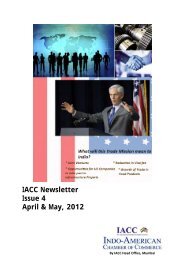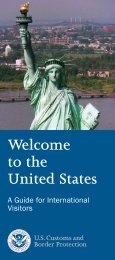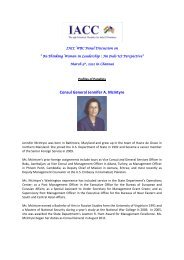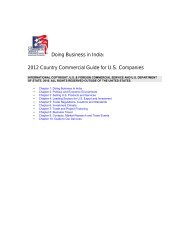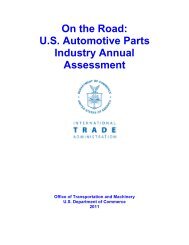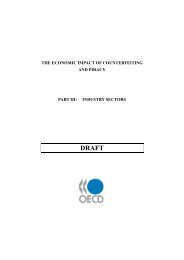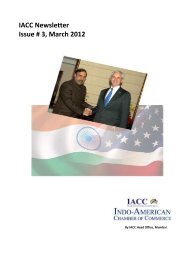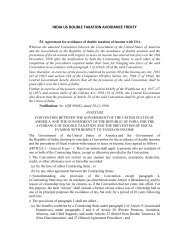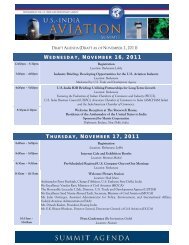Importing into the United States - Indo-American Chamber Of ...
Importing into the United States - Indo-American Chamber Of ...
Importing into the United States - Indo-American Chamber Of ...
You also want an ePaper? Increase the reach of your titles
YUMPU automatically turns print PDFs into web optimized ePapers that Google loves.
FOREIGN DOCUMENTATION<br />
Importers of wines and distilled spirits<br />
should consult <strong>the</strong> Bureau of Alcohol, Tobacco<br />
and Firearms about foreign documentation<br />
required, for example, certificates of origin, age,<br />
etc. Wines or distilled spirits from certain countries<br />
require original certificates of origin as a<br />
condition of entry.<br />
REQUIREMENTS OF OTHER<br />
AGENCIES<br />
In addition, <strong>the</strong> importation of alcoholic<br />
beverages is subject to <strong>the</strong> specific requirements<br />
of <strong>the</strong> Food and Drug Administration.<br />
Certain plant materials, when used for bottle<br />
jackets for wine or o<strong>the</strong>r liquids, are subject to<br />
special restrictions under plant quarantine regulations<br />
of <strong>the</strong> Animal and Plant Health Inspection<br />
Service. All bottle jackets made of dried or<br />
unmanufactured plant materials are subject to<br />
inspection upon arrival and are referred to <strong>the</strong><br />
Department of Agriculture.<br />
Public Law 100-690, codified under 27<br />
U.S.C. 213-219A, requires <strong>the</strong> following health<br />
warning to appear on <strong>the</strong> labels of containers of<br />
alcoholic beverages bottled on or after Nov. 18,<br />
1989:<br />
Government Warning: (1) According to <strong>the</strong><br />
Surgeon General, women should not drink alcoholic<br />
beverages during pregnancy because of <strong>the</strong> risk of<br />
birth defects. (2) Consumption of alcoholic beverages<br />
impairs your ability to drive a car or operate<br />
machinery and may cause health problems.<br />
39. MOTOR VEHICLES AND BOATS<br />
AUTOMOBILES, VEHICLES AND<br />
VEHICLE EQUIPMENT<br />
Safety, Bumper, and Emission Requirements.<br />
As a general rule, all imported motor vehicles<br />
less than 25 years old and items of motor<br />
vehicle equipment must comply with all<br />
applicable Federal Motor Vehicle Safety Standards<br />
in effect when <strong>the</strong>se vehicles or items<br />
were manufactured. A Customs inspection at<br />
<strong>the</strong> time of entry will determine such compliance,<br />
which is verified by <strong>the</strong> original manufacturer’s<br />
certification permanently affixed to <strong>the</strong><br />
vehicle or merchandise. An entry declaration<br />
form, HS-7, must be filed when motor vehicles<br />
or items of motor vehicle equipment are<br />
entered. The HS-7 can be obtained from customs<br />
brokers or ports of entry.<br />
Certain temporary importations may be<br />
exempt from <strong>the</strong> requirements for conformance<br />
if written approval is obtained in advance from<br />
both <strong>the</strong> U.S. Department of Transportation<br />
and <strong>the</strong> Environmental Protection Agency. This<br />
includes vehicles brought in for research,<br />
demonstrations, investigation, studies, testing<br />
or competitive events. Also, EPA form 3520-1<br />
and DOT form HS-7 must be submitted to Customs<br />
at <strong>the</strong> time entry is made for such vehicles.<br />
Vehicles imported for temporary use by<br />
certain nonresidents or by members of foreign<br />
governments or foreign armed forces may not<br />
be required to comply with safety, bumper,<br />
emission, or <strong>the</strong>ft-prevention standards. Nonconforming<br />
vehicles imported by nonresidents<br />
for personal use must be exported at <strong>the</strong> end of<br />
one year. Vehicles described in this paragraph<br />
may also require EPA and DOT declarations<br />
(forms 3520-1 and HS-7, respectively).<br />
A DOT bond in <strong>the</strong> amount of 150 percent<br />
of <strong>the</strong> vehicle’s dutiable value must be posted<br />
at <strong>the</strong> port of entry when a noncertified or nonconforming<br />
vehicle is imported for permanent<br />
use. The importer must also sign a contract<br />
with a DOT-registered importer, who will<br />
modify <strong>the</strong> vehicle to conform with all applicable<br />
safety and bumper standards, and who<br />
can certify <strong>the</strong> modification(s). A copy of this<br />
contract must be furnished to <strong>the</strong> Customs Service<br />
with <strong>the</strong> HS-7 at <strong>the</strong> port of entry. Fur<strong>the</strong>rmore,<br />
<strong>the</strong> vehicle model and model year must<br />
be determined to be eligible for importation.<br />
For additional information or details on<br />
<strong>the</strong>se requirements, contact <strong>the</strong> U.S. Department<br />
of Transportation, National Highway<br />
Traffic Safety Administration, Director of <strong>the</strong><br />
<strong>Of</strong>fice of Vehicle Safety Compliance (NEF-32),<br />
86 U.S. CUSTOMS SERVICE



